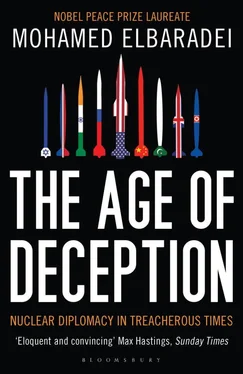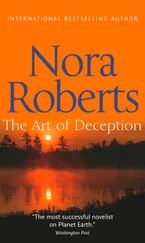The news was immensely disheartening: The Iranians’ failure to declare the Fordow facility to the IAEA at the time of beginning construction, as they were obligated to do, would only add to international distrust of Tehran’s intentions. Still, I resolved to press on with the fuel proposal. I held several telephone conversations with Salehi, in New York and then in India, my next stop on a multicountry visit. I was trying to pin down the Iranians on two dates: one for inspecting the new facility and one for the meeting on the fuel proposal. I also wanted some assurance, before the next P-5+1 meeting, scheduled for October 1 in Geneva, that Tehran agreed with the proposal in principle. Salehi was keen to move things forward, but he was waiting for a green light from Ahmadinejad. The new facility, he said, was not an industrial plant. It had been conceived as a backup enrichment facility during the Bush administration, when the threat of a military strike at Natanz seemed serious. The Fordow plant was carved into a mountain, designed for maximum protection from aerial attack. There was no need for it to be large, Salehi said. It was an expression of Iran’s resolve to preserve its nuclear enrichment technology and knowledge base, regardless of external threat.
As a date was finally set to discuss the fuel proposal, Salehi confirmed that the Iranians were generally in agreement with the plan, but he could not say so officially before the meeting. That was good enough for me to convey to Washington.
A few days later I was told that President Obama wanted to speak to me by phone. He began by thanking me for taking the time to meet with Burns and company on the day of my arrival at the summit in New York. I was impressed, as before, by the sensitivity of his approach. In his view, he said, it was extremely important for the Agency to gain early access to the new facility. “I do not want to interfere with your Agency’s work,” he said, “but I hope you will report promptly to the Board once you visit the facility and have made your own assessment.” He was pleased that we had a date for the fuel proposal meeting and that the Iranians had reacted positively.
While in India, I spoke to CNN-IBN about the revelation of Iran’s new enrichment facility as an unfortunate “setback to the principle of transparency, and to the effort by the international community to build confidence about the Iranian nuclear program.” I explained Iran’s argument about needing the facility as a backup in case of an attack, which is why “they could not tell us earlier on. Nonetheless, they have been on the wrong side of the law, you know, insofar as informing the Agency about the construction—and as you have seen, it has created concern in the international community.”
The Fordow facility notwithstanding, the signals from all sides indicated a desire to conclude the fuel deal. At the P-5+1 meeting in Geneva on October 1, my primary concern was to prevent the discussions from getting sidetracked, particularly by a loose statement from the French, who continued to speak provocatively about Iran’s nuclear program. We put great effort into ensuring that prior to the meeting all parties had a clear understanding of their own position as well as the stands that others might take. We wanted no surprises.
The meeting went off without a hitch, referred to by Obama as a “constructive beginning.” Regarding the fuel proposal and the inspection of the new facility near Qom, the participants largely restated the terms I had already mediated between the United States and Iran. The meeting served as public articulation of a private agreement. Not all the participants realized that things had been precooked.
Just before the end of the meeting, Solana called, reaching me in Kathmandu. The P-5+1, he said, had confirmed that the inspection of the new facility should take place within the next couple of weeks. He wanted to check whether this was all right. The timing was fine, I said, but it was not up to them to set inspection dates. Solana apologized, saying they had not meant to interfere.
I said no more. But the behavior struck me as typical: the Western countries involved in the process always wanted to be perceived as being in charge—to push, to prod, to put pressure, to set deadlines, to dominate the debate, to inflict punishments—which inevitably gave them the appearance of the schoolyard bully and undermined precisely the objectives they hoped to achieve. Solana added that they had gotten the Iranians to agree in principle on the fuel offer. I did not volunteer that this had been prepared in advance, set up through a patient series of discussions with Salehi. I just said I had heard as much in my conversation with President Obama.
At a press conference after the P-5+1 meeting, Obama discussed the progress made. “I have been in close touch with the head of the IAEA, Mohamed ElBaradei, who will be traveling to Teheran in the days ahead. He has my full support.” I marveled at how the world had shifted, in just a few months. After years of being either ignored or attacked as the archenemy of the United States, the IAEA was once again a partner, treated with confidence. It was an unexpected but welcome finale to my tenure with the Agency. I had hoped to last long enough to see a move away from the Bush administration’s policies. But I had not expected to encounter a new president in full command of the issues, reachable by phone, who spoke with appreciation for our work.
From Kathmandu, I arranged to fly on short notice to Tehran on October 3. Meeting me at the Esteqlal Hotel, Salehi reported that Iran was ready to let IAEA inspectors visit the new facility at Fordow. However, there would be a slight delay. Given the public statements by Obama and the West that the inspections had to take place within two weeks, the IAEA would have to wait until after that deadline. Tehran did not want to appear to be taking instruction, whether from the United States or anyone else.
The fuel proposal concept was now also facing a lot of internal opposition in Tehran, yet Salehi had managed to convince Ahmadinejad to go along. The Iranian president, he said, wanted dialogue with the United States, and if anyone could make it happen, it would be Ahmadinejad.
I tried to probe Salehi on what issues Iran might raise at our upcoming fuel proposal meeting. He mentioned a number of possibilities: asking for assistance with refurbishing the Tehran Research Reactor, which was forty years old and had originally been supplied by the United States; alternatively, asking for help with purchasing a new research reactor from the West; or asking the P-5+1 to let Iranian engineers receive training abroad.
Salehi also mentioned a long-standing, contentious issue: uranium Iran had paid for but that, after the 1979 Revolution, had never been delivered. He said Iran might ask France and Germany about finally receiving this uranium. This was not a good idea, I told him. Bringing more uranium into Iran at this stage hardly seemed like a sensible way to defuse the crisis.
On the fuel proposal, I told him the arrangement might call for twelve hundred kilograms of LEU to be shipped out to Russia, where it would be further enriched, and then to France, where the fuel for Iran’s research reactor core would be fabricated.
“This quantity assumes that we need a core for ten years,” Salehi responded. “We might be asking for a core with only a five-year life, which would require less LEU.”
My advice was to get as much LEU out of Iran as possible, to calm the enrichment situation and create an opportunity for negotiation. While this was a technical issue, it had huge political implications.
I also asked whether there was there any chance that Iran might now reconsider a time-out or freeze-for-freeze agreement, to get the dialogue under way. The idea would not sell in Tehran, Salehi said frankly. With all the condemnation from the West, enrichment had become a sensitive matter of national pride. The room for compromise on this was limited. From my discussions with Iranian officials, however, I understood that Iran might be able to implement an undeclared de facto freeze, letting the news reach the public via IAEA reporting.
Читать дальше












